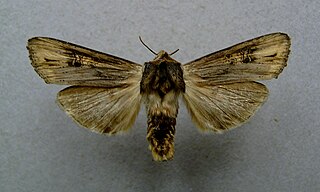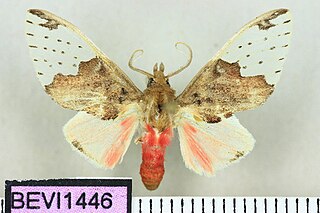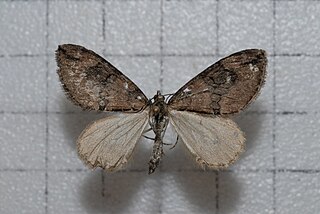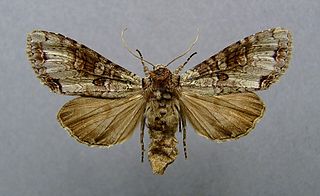Related Research Articles

The red underwing is a moth of the family Erebidae. The species was first described by Carl Linnaeus in his 1767 12th edition of Systema Naturae.
The Folkestone Downs are an area of chalk downland above Folkestone, where the eastern end of the North Downs escarpment meets the English Channel. Part of the Downs is the Folkestone to Etchinghill Escarpment Site of Special Scientific Interest, designated for its geological and biological interest.

Calidota is a genus of moths in the family Erebidae. The genus was erected by Harrison Gray Dyar Jr. in 1901.

Xylena exsoleta, the sword-grass, is a species of moth of the family Noctuidae.

Scaptius is a genus of moths in the family Erebidae erected by Francis Walker in 1855.

Avitta is a genus of moths of the family Noctuidae described by Francis Walker in 1858.

Ecliptopera is a genus of moths in the family Geometridae.

Hemithea is a genus of moths in the family Geometridae erected by Philogène Auguste Joseph Duponchel in 1829. In 1999 there were about 31 species in the genus.

Heterothera is a genus of moths in the family Geometridae described by Hiroshi Inoue in 1943.
Onagrodes is a genus of moths in the family Geometridae.

Schinia obscurata, the obscure schinia moth, is a moth of the family Noctuidae. It is found from Ontario and Quebec south into the United States, where it has been recorded from Illinois, New Jersey, South Carolina, Wisconsin, Kansas, Montana, Nebraska, North Dakota, Oklahoma and Texas.

Polia hepatica, the silvery arches, is a moth of the family Noctuidae. The species was first described by Carl Alexander Clerck in 1759. It is found in temperate Europe and east across the Palearctic to Siberia and Korea. It is not present in northernmost Fennoscandia and the southern parts of the Iberian Peninsula, Italy and Greece. It is also absent from Japan.

Charissa obscurata, the annulet or Scotch annulet, is a moth of the family Geometridae. The species was first described by Michael Denis and Ignaz Schiffermüller in 1775. It is found in most of Europe including the European part of Russia and in Asia Minor, the Caucasus, Armenia and Azerbaijan. In the mountains it rises up to 1800 meters. The habitat is rocky dry grasslands, boulder corridors, quarries as well as rocky steppe heaths and wine-growing areas.
Eupithecia obscurata is a moth in the family Geometridae. It is found in French Guiana.
Onagrodes victoria is a moth in the family Geometridae. It is found in southern Myanmar and on Borneo.
Onagrodes oosyndica is a moth in the family Geometridae. It is found on Peninsular Malaysia, Sumatra, Borneo and Sulawesi.
Onagrodes eucineta is a moth in the family Geometridae. It is found on Peninsular Malaysia and Borneo.
Onagrodes barbarula is a moth in the family Geometridae. It is found on New Ireland.
Drasteria obscurata is a moth of the family Erebidae. It is found in Iran, Afghanistan, Kazakhstan, Kyrgyzstan, Uzbekistan and Tajikistan.

Zenophleps obscurata is a species of geometrid moth in the family Geometridae. It is endemic to North America.
References
- ↑ Yu, Dicky Sick Ki. "Onagrodes obscurata Warren 1896". Home of Ichneumonoidea. Taxapad. Archived from the original on March 27, 2016.
- ↑ Holloway, Jeremy Daniel. "Onagrodes Warren". The Moths of Borneo. Retrieved March 9, 2019.